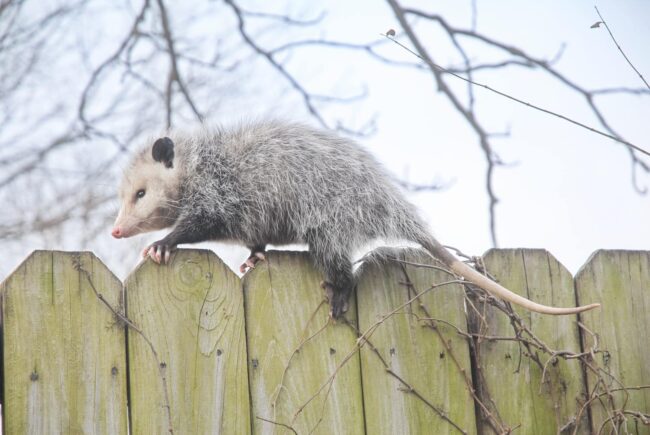Ever witnessed a possum suddenly flop to its side, seemingly lifeless, when confronted by a potential threat? If you’ve been curious about how long a possum plays dead, why it happens, and the intricacies surrounding this peculiar behavior, you’ve landed on the right page.
Table Of Contents
−- What Exactly is Happening When a Possum Plays Dead?
- How Long Does the “Death Feigning” Last?
- Understanding the Stages of Tonic Immobility in Possums
- Why Do Possums Resort to Playing Dead?
- Do Other Animals Employ This Technique?
- What are the Risks Associated With Playing Dead?
- How to Distinguish Between a “Playing Dead” Possum and a Truly Dead One?
- What to Do if You Find a ‘Playing Dead’ Possum in Your Yard?
- Conclusion
What Exactly is Happening When a Possum Plays Dead?
The act of a possum “playing dead” is scientifically referred to as “tonic immobility” or “death feigning.” Interestingly, this isn’t an act or a performance; rather, it’s a biological response triggered by extreme stress. The possum isn’t consciously choosing to play dead; its body is reacting involuntarily to perceived threats. Predators often lose interest when they believe their prey is dead, providing the possum a unique survival advantage.

How Long Does the “Death Feigning” Last?
The time span for which a possum stays in this motionless state isn’t universally fixed. It is highly contingent on the specific circumstances—such as the kind of predator and the immediate environment. In some instances, possums have been documented to remain “dead” for a brief period of 40 minutes. In more extreme cases, this behavior has lasted for over 3 hours. This period of unresponsiveness is generally a byproduct of the possum’s body entering a shock-like, catatonic state, making it temporarily immobile.
Understanding the Stages of Tonic Immobility in Possums
When a possum enters this peculiar state, its body undergoes a series of changes. Typically, the animal stiffens and topples over, lying on its side with a fixed, glazed expression. To make the ‘corpse’ even less appealing, the possum might emit a foul-smelling fluid from its mouth, nose, and even its anus. This added layer of deterrence serves to further discourage predators who might still be skeptical about the possum’s state.
Why Do Possums Resort to Playing Dead?
Initially, possums will try other tactics to deter predators, such as hissing and showing their teeth. When these methods fail, that’s when the possum resorts to its last-ditch defense mechanism—entering a catatonic state. Evolutionary biologists believe that this involuntary physiological response serves to disorient or confuse predators, leading them to abandon the immobile possum, assuming it to be already dead.
Do Other Animals Employ This Technique?
Indeed, possums are not alone in this game of survival. While the term “playing possum” is largely associated with these creatures, similar behaviors—known as thanatosis—have been observed in other animals, including rabbits, skunks, badgers, and even domestic pets like cats and dogs. Each species has its unique variation of this death-feigning act, tailored to its specific survival needs.
What are the Risks Associated With Playing Dead?
While the act of playing dead might deter predators, it isn’t without risks. The possum is left vulnerable during its catatonic state. Predators might return, or new ones could arrive, posing an even greater danger. Prolonged states of tonic immobility can also lead to dehydration and may cause internal physiological issues like organ failure if the possum doesn’t ‘wake up’ in time.
How to Distinguish Between a “Playing Dead” Possum and a Truly Dead One?
If you ever encounter an immobile possum, a close observation is crucial before taking any action. Look for signs like steady breathing or tiny, almost unnoticeable movements such as the twitching of ears or the tail. If you poke the animal gently and it doesn’t react, chances are it’s in a state of tonic immobility and not actually dead.
What to Do if You Find a ‘Playing Dead’ Possum in Your Yard?
Firstly, give the possum ample time and space to recover from its catatonic state. If it’s necessary to move the possum—for its safety or yours—ensure that you’re wearing thick gloves and handle the animal cautiously, ideally by approaching it from behind. If you’re uncertain about how to safely manage the situation, it’s always advisable to consult animal control experts for professional guidance.
Conclusion
Tonic immobility in possums is a fascinating adaptation aimed at survival. While the duration can range from 40 minutes to several hours, it’s imperative to note that the possum isn’t willingly “playing dead” but is involuntarily reacting to extreme stress. So, the next time you encounter a possum lying motionless, remember that it’s in a vulnerable state and deserves space and respect while it recovers.

Editorial Staff
Our writers, editors, content managers, and SEO specialist. We all take part in crafting amazing articles. We spend hours ensuring that each article is based on facts, researched, and thorough. You'll never want to click the back button to look for more answers other than here!
